Galaxies
NGC 1365
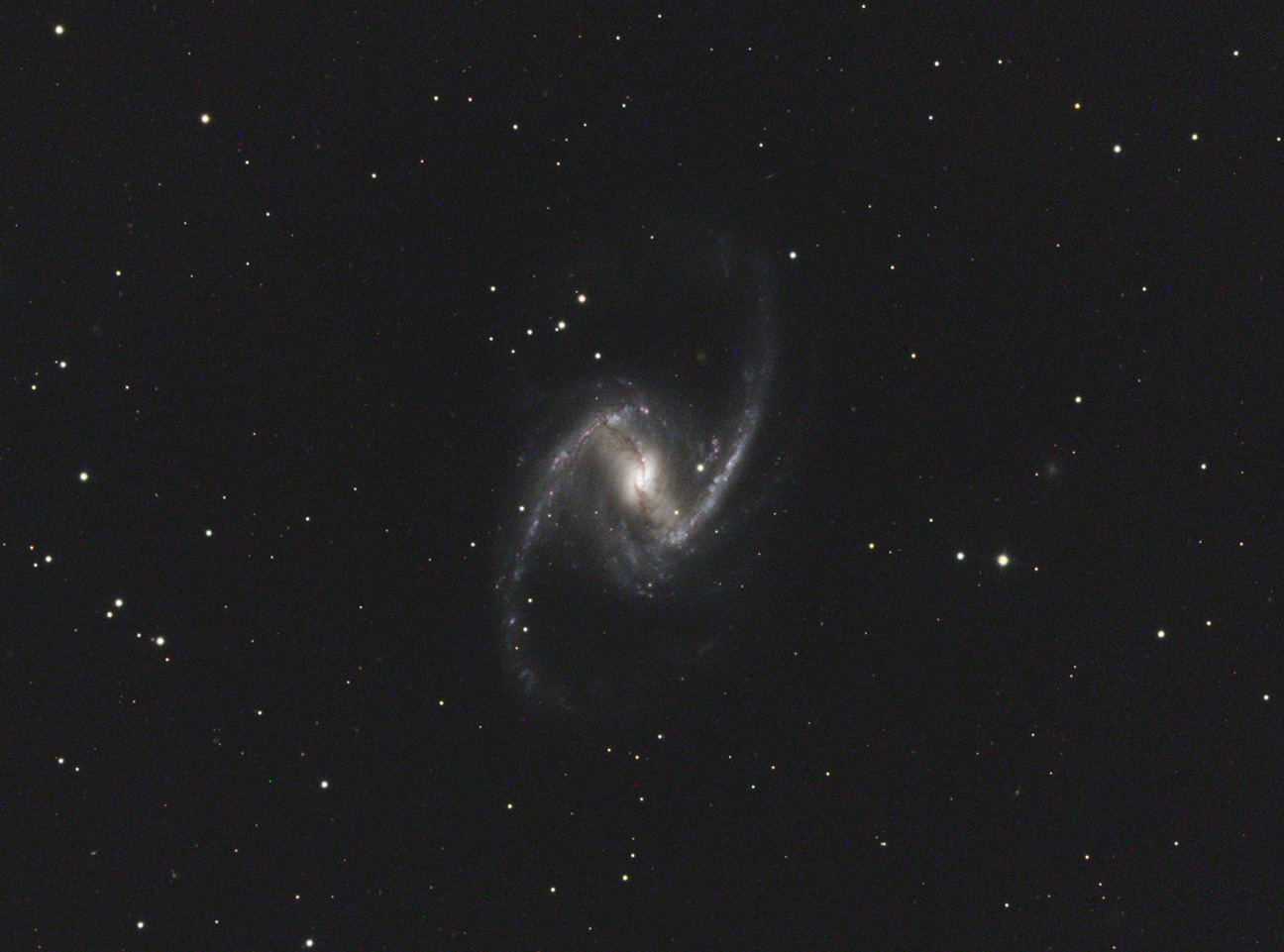
NGC 1365 in Fornax. Taken on Sept. 30 and Oct. 13, 2009 using a remote observatory in Australia. I used a Lightbuckets telescope remotely to capture this data. The telescope was a 24inch RC and the camera was an Apogee Alta U16m. This remote observatory is now shutdown. This is an LRGB photo with L=8x5min, R,G,B=4x5min each. The observatory was never able to gather all the scheduled observing runs, so I processed what data was taken. MaximDL was used to combine each color channel, then PixInsight was used to make the combined LRGB image. Some touchups were made with Photoshop CC.
Click on the image to see a larger version in a new window.
Back to the top of the page
Back to Mark's Astrophotography Home
NGC3184 in Ursa Major - Jun. 7, 2024

This is the "Little Pinwheel" galaxy NGC 3184 located on the western side of Ursa Major.
This is one hour of exposure time taken over two nights (May 30 and June 7).
The galaxy was well past the meridian
at end of evening twilight and moving into the trees in my neighbor's yard.
The galaxy is fairly small measuring 6.75 arc minutes in size and this view is zoomed in.
Click on the image for a larger view in a new window.
Details:
Location: Front yard Cary, NC
Camera: ASI294mc-Pro
Exposure: 40 x 90s (1 hr.) gain 150
Filter: UV/IR
Scope: TeleVue Genesis 4" f/5 refractor
Mount: iOptron GEM-45
Guider: Orion 60mm finder/guider
Capture software: ASIAir
Guiding software: ASIAir
Calibration frames: darks, flats, flat-dark
Processing software: Pixinsight, Photoshop CC, GradiditneXterminator, NoiseXTerminator,
and StarXTerminator.
Weather conditions: Clear with temps around 65F.
Notes: This image is heavily cropped to remove trees. North is up.
Back to Mark's Astrophotography Home
M98 and M99 in Coma Berenices - Apr. 28, 2024

The two bright galaxies in this image are face on spiral M99 (lower left)
and almost edge on spriral M98 (top right).
Both galaxies are located in Coma Berenices around 6.5 degrees from the bright star Denebola in Leo.
Looking at the larger view, there are many small faint galaxies,
but the brightest is NGC4327 at the upper left center.
North is at the top.
Click on the image for a larger view in a new window.
Details:
Location: Front yard Cary, NC
Camera: ASI294mc-Pro
Exposure: 60 x 90s (1.5 hrs.) gain 150
Filter: UV/IR
Scope: TeleVue Genesis 4" f/5 refractor
Mount: iOptron GEM-45
Guider: Orion 60mm finder/guider
Capture software: ASIAir
Guiding software: ASIAir
Calibration frames: darks, flats, flat-dark
Processing software: Pixinsight, Photoshop CC, GradiditneXterminator, NoiseXTerminator,
and StarXTerminator.
Weather conditions: Clear with temps around 65F.
Notes: This image is not cropped. North is up.
Back to Mark's Astrophotography Home
NGC147 and NGC185 in Cass, Oct. 12, 2023

NGC147 (right) and NGC185 (left) are small satellite galaxies of M31
located in the constellation Cassiopeia.
They are about 7 degrees away from M31.
I used an Astronomic CLS filter on this shot to cut down some of the light pollution in this part
of the sky, but one of the side effects of the filter is that it will turn the white stars in
the image a teal blue.
Click on the image for a larger view in a new window.
Details:
Location: Front yard Cary, NC
Camera: ASI294mc-Pro
Exposure: 41 x 90s exposures gain 150
Filter: UV/IR, Astronomic CLS
Scope: TeleVue Genesis 4" f/5 refractor
Mount: iOptron GEM-45
Guider: Orion 60mm finder/guider
Capture software: ASIair
Guiding software: ASIair
Calibration frames: darks, flats, flat-dark
Processing software: Pixinsight, Photoshop CC, Topaz Denoise AI
Weather conditions: Cool and moist.
Notes: This image is cropped to about 2 by 1.25 degrees.
Back to Mark's Astrophotography Home
Spiral galaxy M90 in Virgo , Apr. 11, 2023

This is spiral galaxy M90 along with small galaxy IC 3583 just to its upper right in Virgo.
Many small galaxies can be seen near the lower end of the main galaxy.
Shot for 2 hours at a focal length of 1460mm with my C-8 SCT, this is a slightly cropped view of the
micro 4/3 sensor of my camera.
M90 is a fairly large galaxy at 9.5' x 4.5'.
I had to deal with some pretty wicked light pollution gradents during processing.
Click on the image for a larger view in a new window.
Details:
Location: Front yard Cary, NC
Camera: ASI294mc-Pro
Exposure: 60 x 2m (2 hrs. total) gain 150
Filter: UV/IR
Scope: Celestron EdgeHD 800 SCT with f/7 reducer
Mount: iOptron GEM-45
Guider: Orion 60mm finder/guider
Capture software: ZWO ASIair Plus
Guiding software: ZWO ASIair Plus
Calibration frames: darks, flats, flat-dark
Processing software: Pixinsight, Photoshop CC
Weather conditions: Clear and cool temp low 60s
Notes: The photo displayed is a slight crop of the original frame.
Simple processing in PixInsight: calibrate, stack, DBE, SPCC, BlurXterminator.
In Photoshop: resize, Topaz, and convert to JPG.
Back to Mark's Astrophotography Home
Deerlick Group and Stephan's Quintet, Oct. 24, 2022
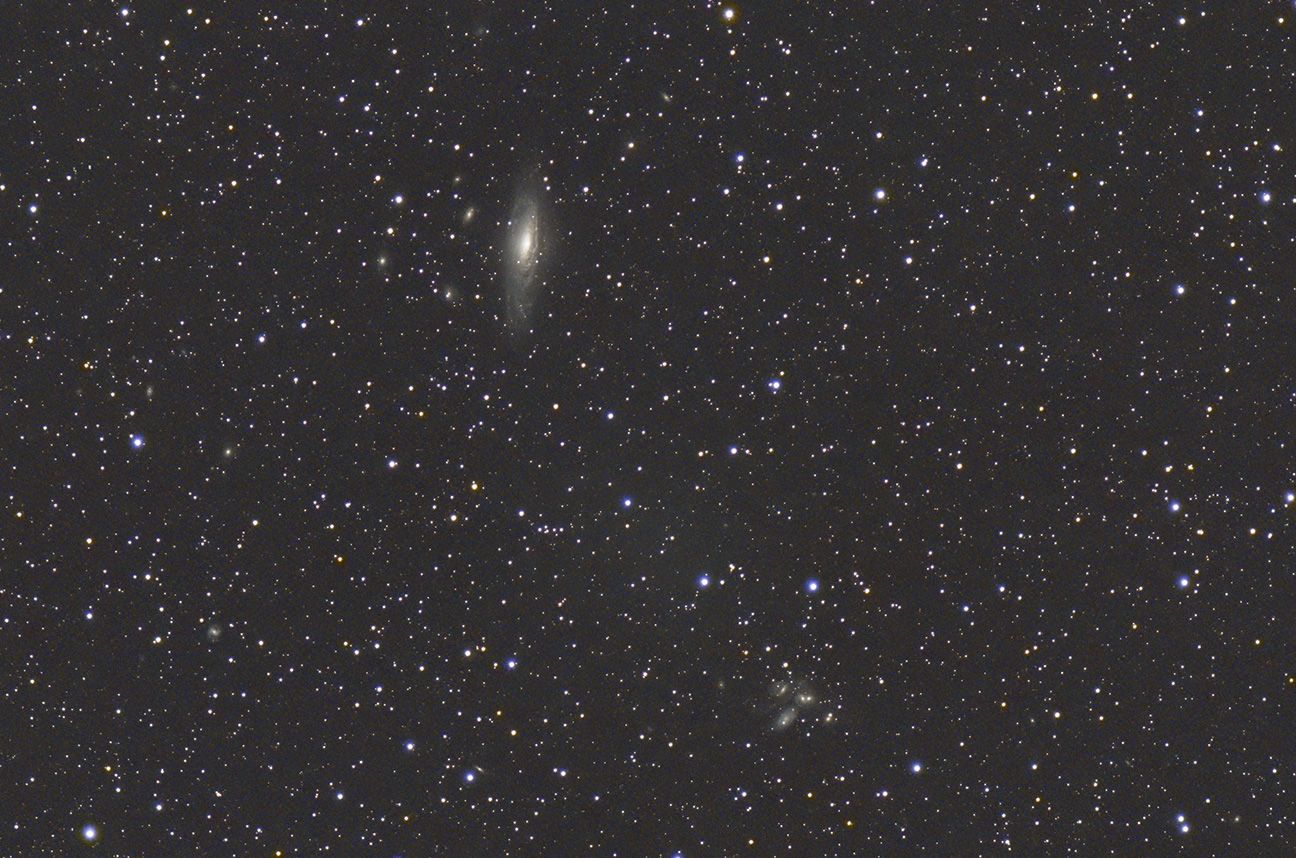
The Deerlick group of galaxies including NGC 7331 (upper left)
and Stephan's Quintet of galaxies (lower right).
There are lots of other small galaxies scattered over the frame.
I need more sub-exposures but that will have to wait until later.
I did not use any light pollution filters this time so 120 seconds is about
as long as I can go at f/5 from my light polluted home.
Click on the image for a larger view in a new window.
Details:
Location: Front yard Cary, NC
Camera: ASI294mc-Pro
Exposure: 27 x 120s gain 150
Filter: UV/IR
Scope: Televue Genesis 4" f/5 refractor
Mount: iOptron GEM-45
Guider: Orion 60mm finder/guider
Capture software: ZWO ASIair Plus
Guiding software: ZWO ASIair Plus
Calibration frames: darks, flats, flat-dark
Processing software: Pixinsight, Photoshop CC, Topaz AI
Weather conditions: Very clear and no haze
Notes: The photo displayed is a crop of the original frame.
Back to Mark's Astrophotography Home
Spiral Galaxy M94 in Canes Venatici, June 18, 2022
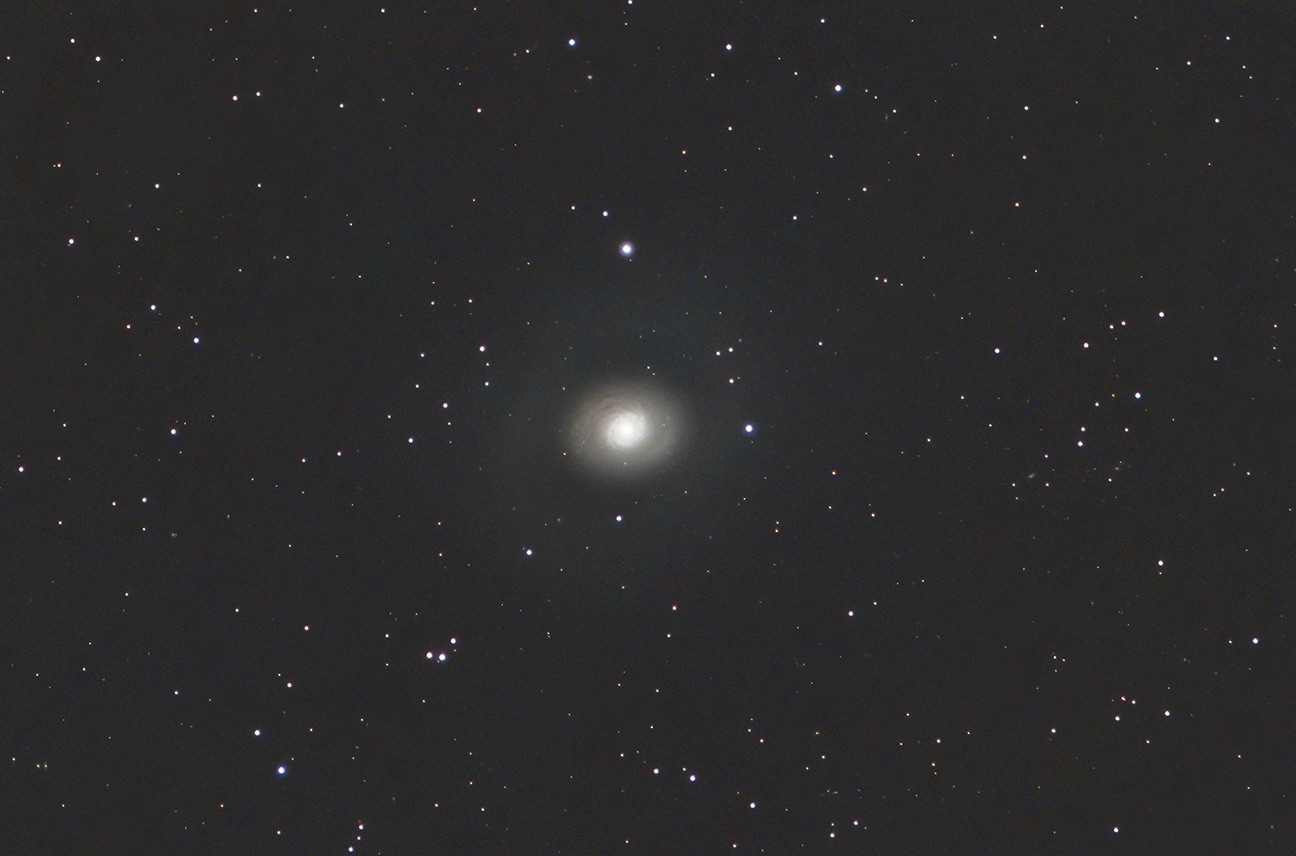
M94 - The Croc's Eye Galaxy taken over two nights about a month apart.
Exposure time was nearly 2.5 hours.
Note the faint outer halo around the galaxy.
Click on the image for a larger view in a new window.
Details:
Location: Front yard Cary, NC
Camera: ASI294MC-Pro
Exposure: 51 x 90s and 58 x 60s gain 150
Filter: Optolong L-Pro (5/28) and Astronomik CLS (6/18)
Scope: Televue Genesis 4" f/5 refractor
Mount: iOptron GEM-45
Guider: 60mm Orion finder/guider
Capture software: APT and NINA 2.0
Guiding software: PHD
Calibration frames: darks, flats, flat-dark
Processing software: Pixinsight, Photoshop CC, and Topaz Denoise AI
Weather conditions: Clear with low humidity. Mild temperatures. Great for June!
Notes: The first sequence of shots was taken on May 28, 2022.
At the time, I felt these were over exposed.
The second set was taken on June 18, 2022. The 60s exposures here seemed proper.
The image was cropped.
Back to Mark's Astrophotography Home
The Leo Triplet of Galaxies, April 3, 2022
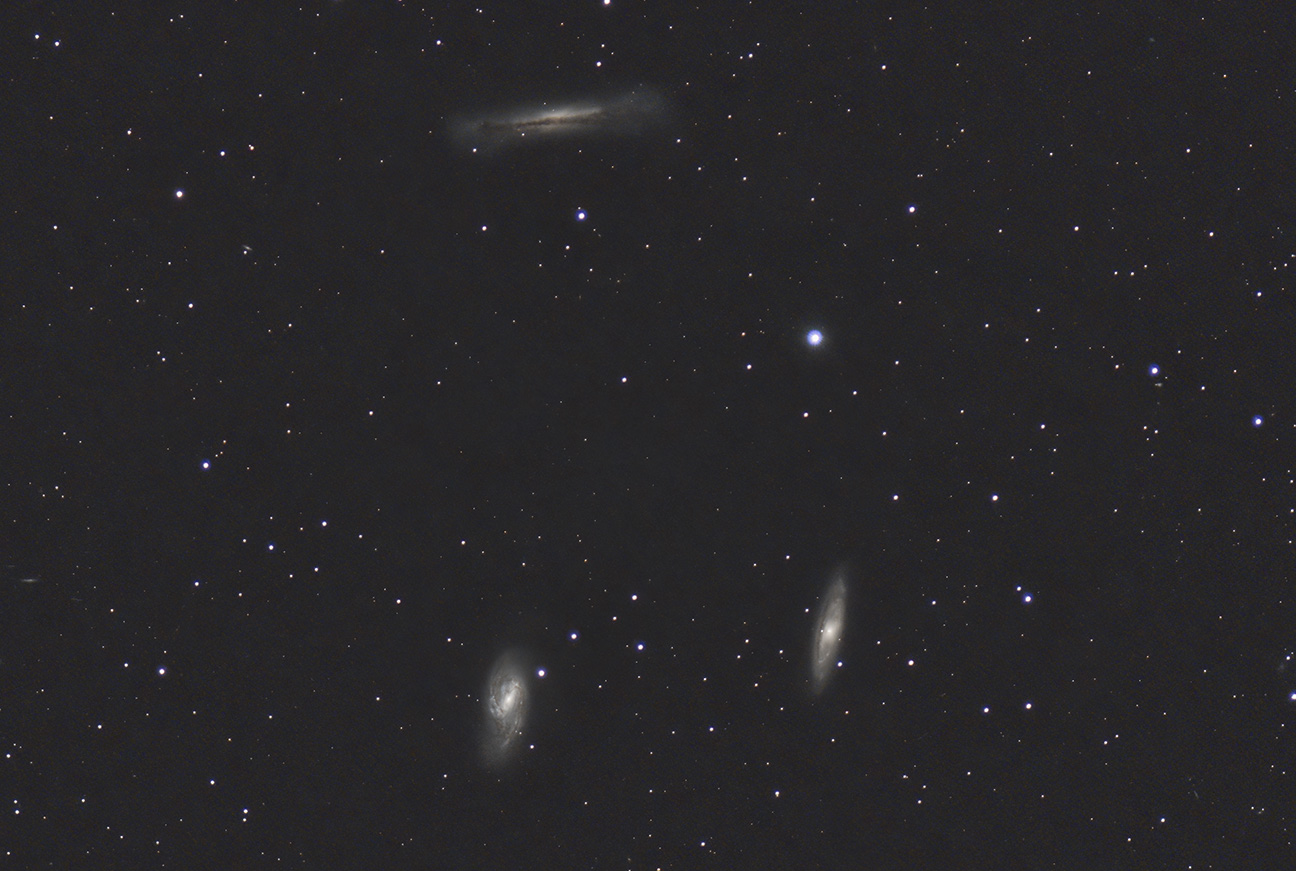
The Leo Triplet: M65 (lower right), M66 (lower left), and NGC 3628 aka the Hamburger Galaxy (top).
I was very pleased with the detail I got in M65 and especially M66.
Several other faint galaxies are visible especially in the larger view.
Click on the image for a larger view in a new window.
Details:
Location: Front yard Cary, NC
Camera: ZWO ASI294MC-Pro
Exposure: 45 x 2 minutes gain 150
Filter: Optolong L-Pro
Scope: Televue Genesis 4" f/5 refractor
Mount: iOptron GEM-45
Guider: 60mm Orion finder/guider with ASI120mm-s camera
Capture software: APT
Guiding software: PHD2
Calibration frames: 13 flats and 13 darks
Processing software: PixInsight, Photoshop CC, and Gradient xTerminator
Weather conditions: Very cool but steady and dry.
Notes: The image was cropped. Focused with a Batinov mask.
Back to Mark's Astrophotography Home
M106 and companions, April 2, 2021

M106 and six fainter friends. The bright galaxy to the center
left is M106, a barred spiral in Canes Venatici. Notice the faint spiral arms
starting to show outside the brigher nucleus area. Directly below M106 is the
very faint irregular galaxy PGC 39615. It is shining at magnitude 15.8 and it's
size is 0.7' x 0.8'. The lenticular looking galaxy to the upper right of M106
is NGC 4248. It is listed as a spiral galaxy magnitude 12.4 and size 2.4' x
1.1'. To it's right and slightly higher are two more small faint galaxies, NGC
4232 at magnitude 13.7 and immediately above it is NGC 4231 at magnitude 13.6.
Near the bottom right corner of the photo is NGC 4217, a very nice edge on
spiral galaxy. It's size is 5.2' x 1.5 and it's magnitude is 11.3. Finally, to
the lower left of NGC 4217 is NGC 4226 at magnitude 14.5. You can start to see
some spiral structure to it also.
Click on the image for a larger view in a new window.
Details:
Location: Front yard Cary, NC
Camera: ZWO ASI294MC-Pro
Exposure: 46 x 2 minutes gain 120
Filter: UV/IR and Astronomik CLS
Scope: Televue Genesis 4" f/5 refractor
Mount: iOptron GEM-45
Guider: 60mm Orion finder/guider with ASI120mm camera
Capture software: APT
Guiding software: PHD2
Calibration frames: 13 flats and 13 darks
Processing software: PixInsight, BlurxTerminator, NoisexTerminator, and Affinity Photo
Weather conditions:
Notes: The image was cropped. The CLS filter tends to turn white stars teal blue.
This image was never published until June of 2025 after using new Pixinsight tools.
This image superseeded the similar mono version of May 28. 2006.
It was possible this image was captured at Big Woods.
Back to Mark's Astrophotography Home
NGC3718 in Ursa Major - May 7, 2021
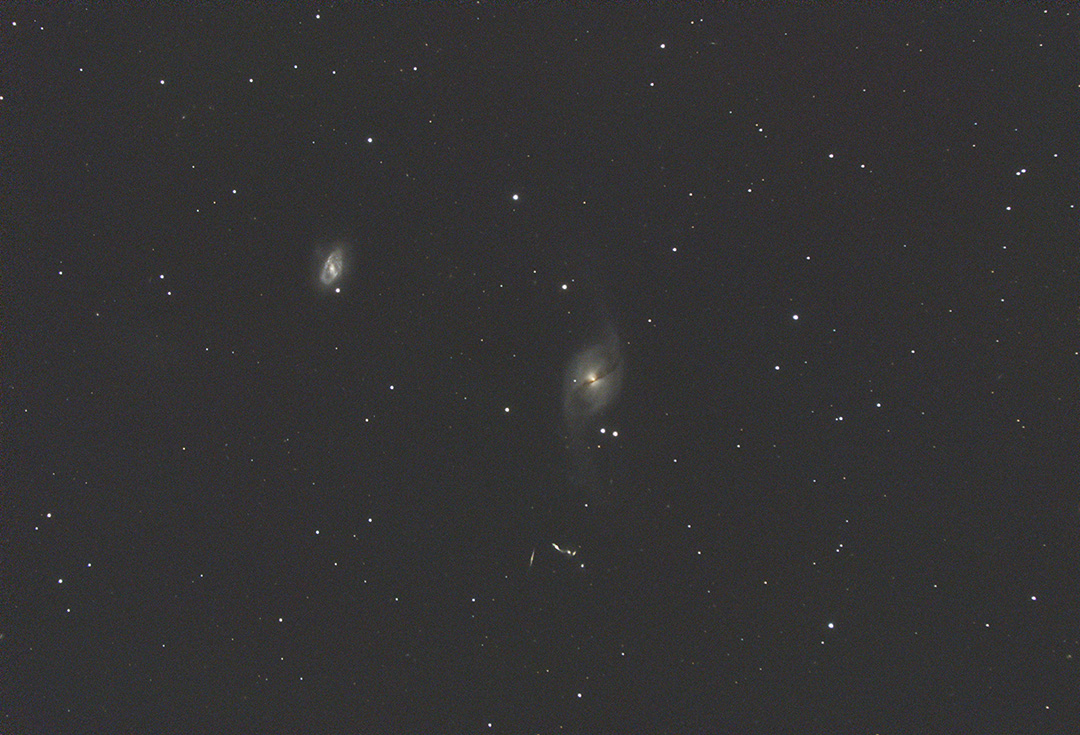
Galaxies NGC 3718 (center), NGC 3729 (upper left), and Hickson 56 a group of 5
small galaxies (lower center).
The image has been cropped to 66% of the original frame.
Location: Cary, NC in my front yard
Camera: ASI294MC-pro gain:150
Exposures: 41 x 2 minutes (1 hr. 22 min.)
Filter: none
Scope: Celestron Edge HD 800 (C-8) at f/7 1400mm fl
Mount: iOptron GEM-45
Guider: Orion 60mm finder with ASI-120mm camera
Capture software: APT
Guiding software: PHD2
Processing software: Pixinsight and Photoshop
Notes: Conditions were very moist after rain earlier that day.
I also got a late start due to some kind of pointing error with the mount.
This was the first time using the Edge HD 800 in over a year.
Pixinsight was used for data reduction, align, stack, crop, Photometric CC,
and convert to tiff.
Photoshop CC was for GradXterminator, noise reduction, color balance, curves, and
convert to jpg.
For a larger view in a new window, click on the image.
Back to Mark's Astrophotography Home
M101 - June 13, 2020
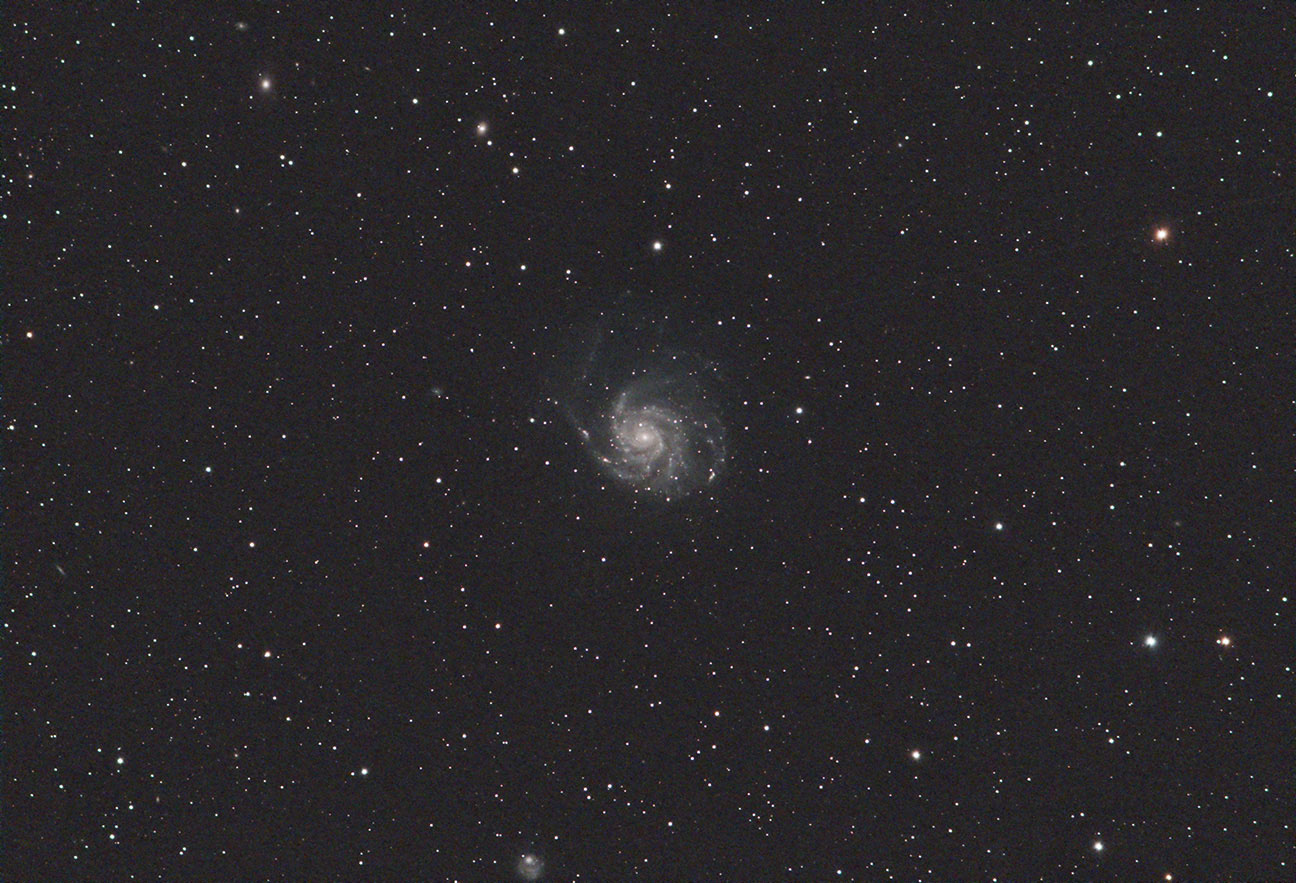
M101 - a spiral galaxy in Ursa Major photographed from home in Cary, NC.
This photo is a combination of 15 x 2 minute exposures.
It was taken through my 4" Genesis refractor and my ZWO ASI 294mc-pro camera guided
by a 60mm finder scope with an ASI120mm camera.
An Astronomic CLS filter was used.
The mount used was my iOptron GEM-45.
I used APT for the image capture and PHD2 for guiding.
PixInsight was used to reduce, combine, and create a TIFF file for import to Photoshop.
I also used the Photoshop GradientXTerminator plug-in.
Click on the image to see a larger version in a new window.
Back to Mark's Astrophotography Home
Markarian's Chain of Galaxies in Virgo - April 27, 2020
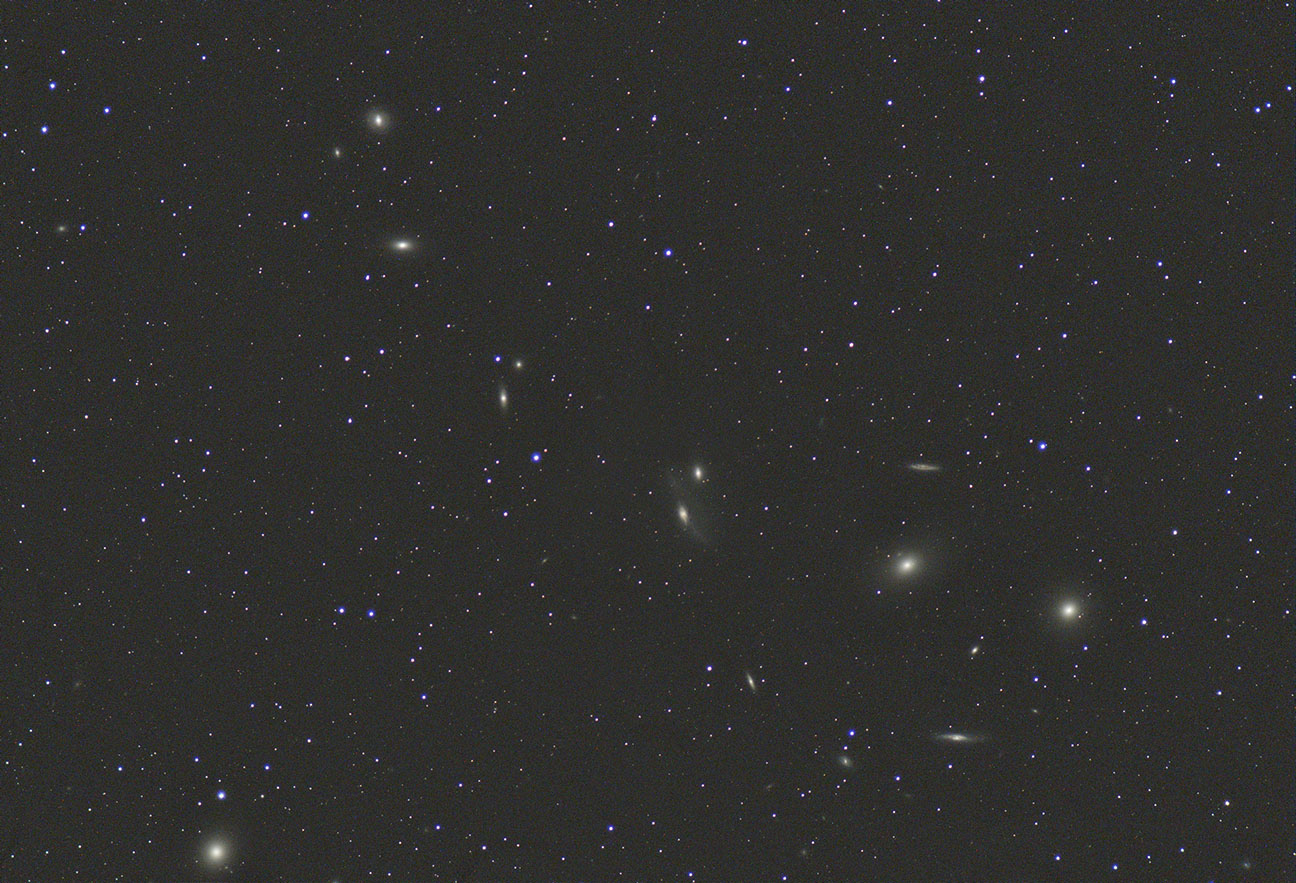
Markarian's Chain includes several bright Messier elliptical galaxies including
(moving from right to left then down) - M84, M86, and M87 near the bottom edge.
The field of view is approximately 1.5 degrees high x 2 degrees wide.
There was a 15% crescent moon 20 degrees up in the western sky at start of the exposures.
This was my first attempt at guided astrophography with my new iOptron GEM45.
I managed to get 38x60s images while Virgo was getting pretty close to the meridian
on the east side.
I was using my ZWO ASI294mc-cool camera.
The gain was mistakenly set at 200!
The ASI294 was attached to my TeleVue Genesis 4" f/5 refractor.
I was guiding with an Orion 60mm finder with an attached ASI120mm guide camera.
I used APT for image capture, PHD2 for guiding,
PixInsight for image reduction and initial stretch,
and then Photoshop 2020 with GradientXTerminator for the final image.
With all the light pollution from my house in Cary,
I was amazed I got a decent image.
GradientXTerminator made a huge difference.
Click on the image for a larger view in a new window.
Back to the top of the page
Back to Mark's Astrophotography Home
M63 galaxy in Canes Venatici - May 28, 2019

M63 is one of the most beautiful spiral galaxies in the northern sky.
Note the dark band covering part of the spiral arms on the bottom left side of the galaxy.
The skies tonight were not perfectly clear, but were better than average for this time of year in NC.
Daytime temperatures reached 95 today making the evening very warm -
my camera was only cooling down to -5 degrees C.
Partly cloudy skies shut me down by 1 am.
This is my second attempt at using the ASI294MC Pro camera attached to my Celestron HD 800 (C-8) working at f/7.
35 x 90 seconds (52.5 minutes total) images at unity gain were taken from my front yard in Cary.
The image is cropped from full frame.
This is an updated version of the photo originally posted here.
Additional frames were added to the stack and some noise reduction was performed.
The Losmandy G-11 was guided by an Orion 9 x 60 finder guider with an attached
ASI 120mm-s guide camera. I am still having guiding troubles at this focal length (1400mm).
The images were captured with Maxim DL, calibrated, stacked, and stretched with PixInsight,
and final touchups were done with Photoshop CC.
This image was reprocessed in 2024 using BlurXterminator and NoiseXterminator.
Click on the image for a larger view in a new window.
Back to the top of the page
Back to Mark's Astrophotography Home
M59 and M60 galaxies in Virgo - May 21, 2019
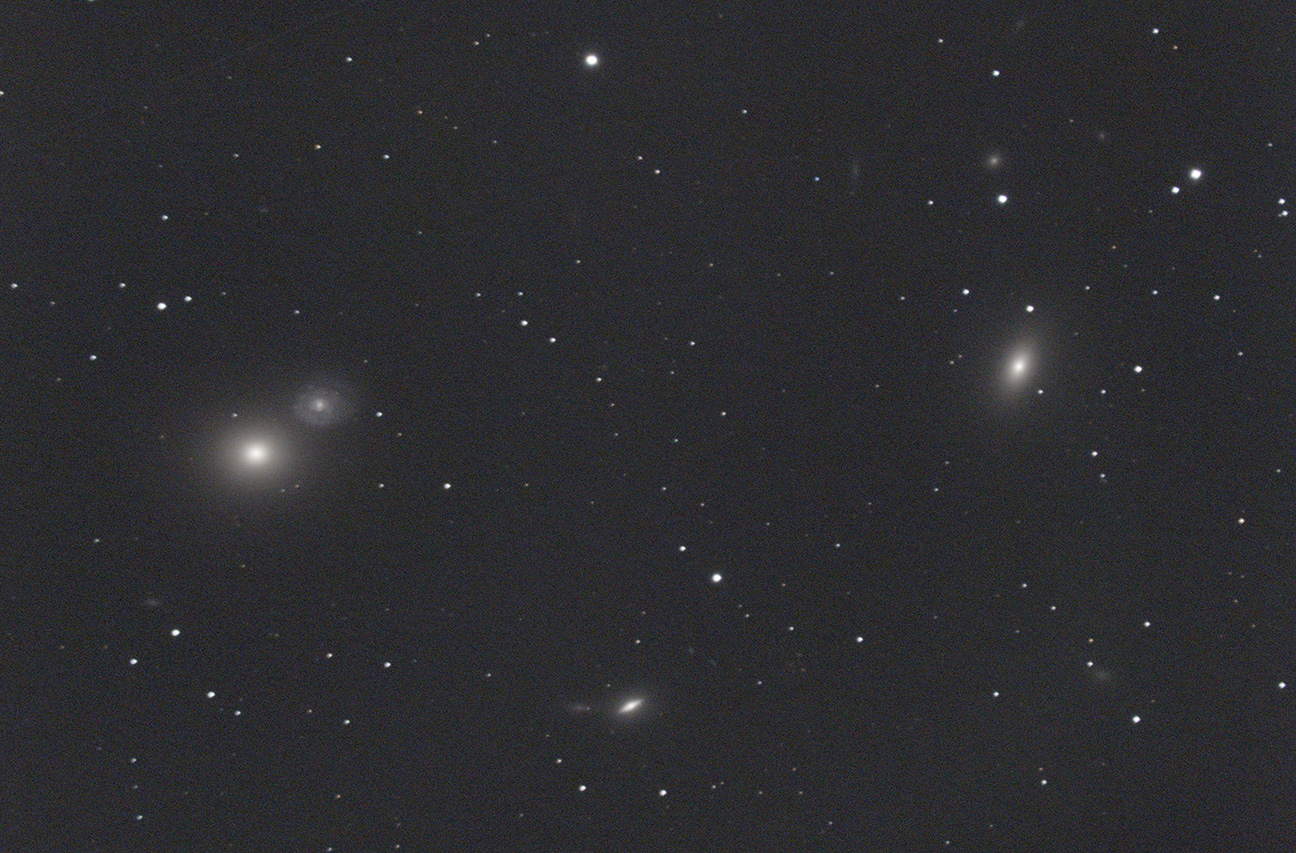
M59 is on the right with M60 and close companion NGC4647 on the left. NGC4667 is at lower center. There are lots of fainter galaxies scattered around. This is my "second light" photo with my new ASI-294MC Pro camera, but this time I used my Celestron Edge HD 800 at f/7 (1400 mm focal length). Since it was very windy and the scope was shaking, I had very low expectations for this shot. The wind shut me down completely by 11:15 pm. My stars are not round, but they don't look terrible at this scale. I only managed 20 x 90 seconds of images at unity gain all taken from my front yard in Cary. The image is slightly cropped from full frame. The Losmandy G-11 was used with the shots guided by an Orion 9 x 60 finder guider with an attached ASI 120mm-s guide camera. The images were captured with Maxim DL, calibrated, stacked, and stretched with PixInsight, and final touchups were done with Photoshop CC.
Click on the image for a larger view in a new window.
Back to the top of the page
Back to Mark's Astrophotography Home
Galaxy NGC7479 - Oct. 29, 2018
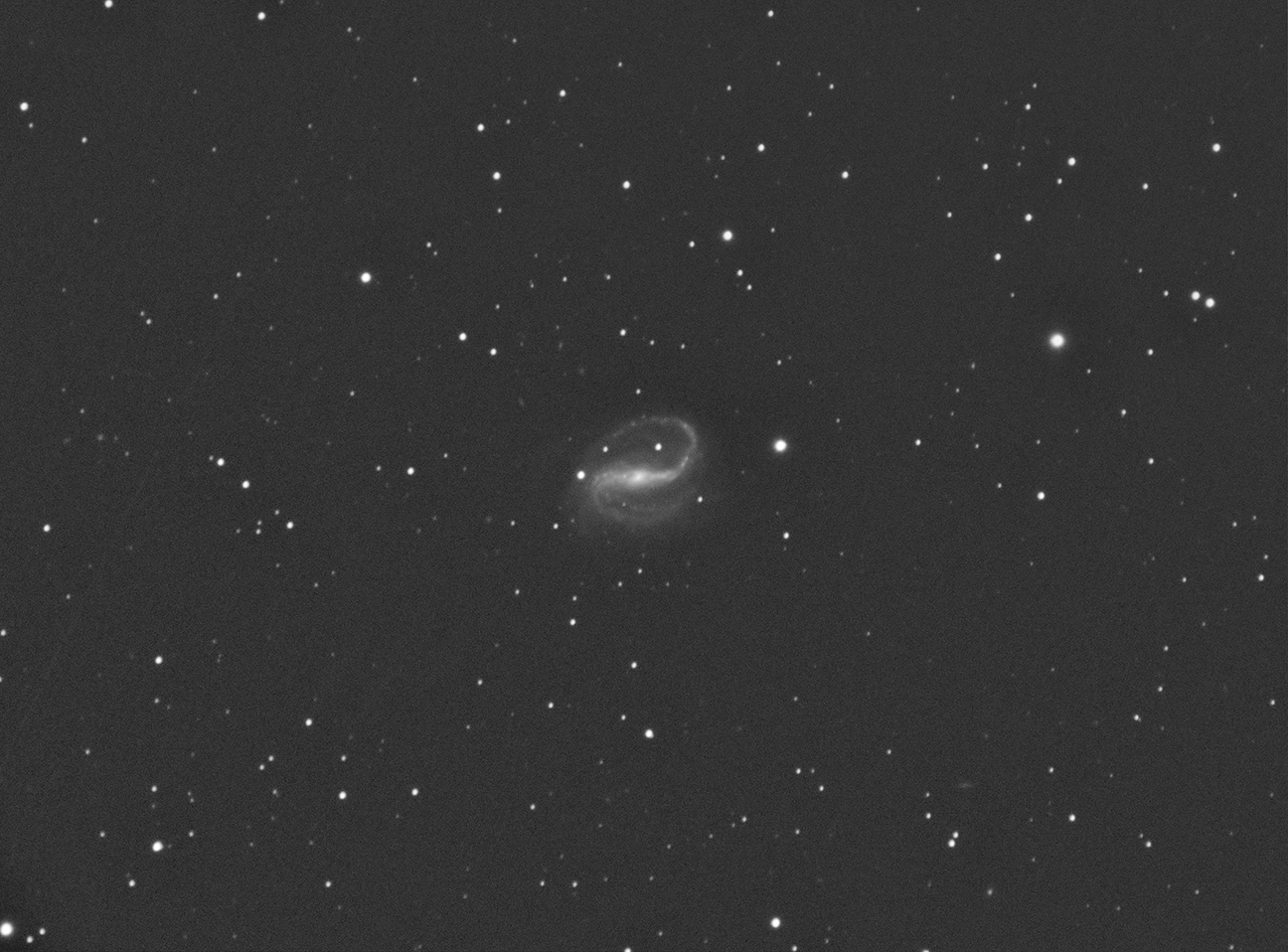
Barred spiral galxay NGC-7479 in Pegasus - magnitude 10.9, size 4' x 3.1'.
North is to the left.
This galaxy had a supernova in it 9 years ago - see this link
for my animation taken back then.
Telescope: Celestron Edge HD800 with f/7 reducer (1400mm). Mount: Losmandy G-11 unguided.
Camera: ZWO ASI1600mm-c.
Location: My front yard in Cary, NC.
Conditions: The moon was up during the second half of image capture session.
There were lots of street lights and porch lights lighting up my area.
Since I was not guiding and my polar alignment was off a bit,
I used the best 37 of the 40 subframes captured based on the eccentricity of the stars so that worked out to be
37 x 60 second lights, 13 each of darks, flats, and flat-darks all shot at unity gain.
This is a crop of the central 1/2 of the full frame.
Images were captured using MaximDL 5. Data reduction and stacking was done with PixInsight.
The final image was made with Photoshop - levels and curves, GradientXTerminator, noise reduction,
and convert to jpg.
Click on the image for a larger view in a new window.
Back to the top of the page
Back to Mark's Astrophotography Home
Galaxy NGC891 - Nov. 10, 2018
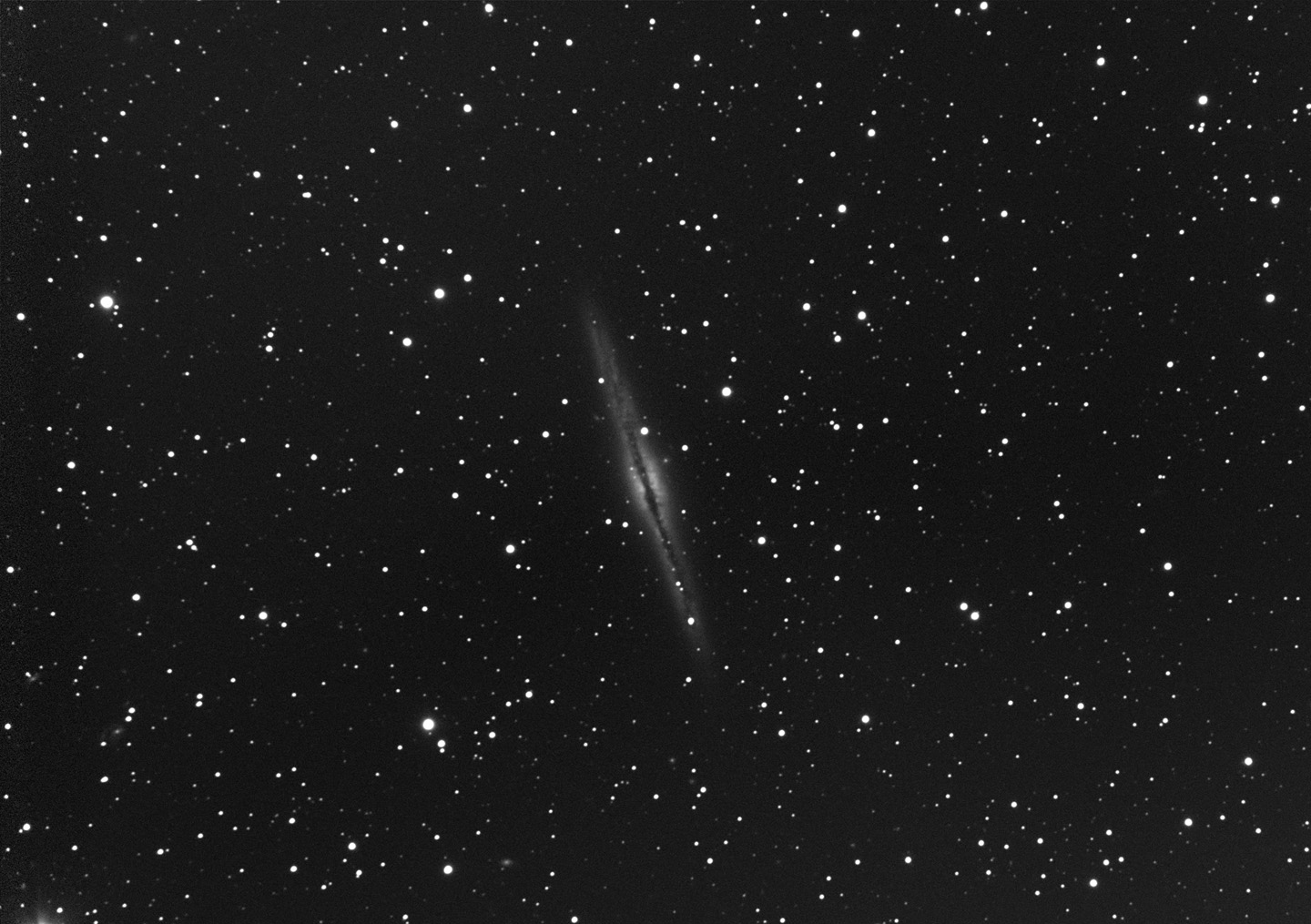
Edge-on spiral galxay NGC-891 in Andromeda - magnitude 10.1, size 11.7' x 1.6'.
North is to the top.
Telescope: Celestron Edge HD800 with f/7 reducer (1400mm). Mount:
Losmandy G-11 guided with an 80mm Brandon refractor and ATIK 16-IC.
Imaging Camera: ZWO ASI1600mm-c.
Location: My front yard in Cary, NC.
Conditions: Clear and cold with temps around 40. Lots of ambient light.
Exposure: 21 x 90 second lights, 13 each of darks, flats, and flat-darks all shot at unity gain.
This is a slight crop of the full frame.
Images were captured using MaximDL 5.
Data reduction and sigma-clip combination was also done with MaximDL.
The final image was made with Photoshop CS2 - levels and curves, GradientXTerminator, noise reduction,
and convert to jpg.
ImagesPlus was used for a slight sharpening of the image.
Click on the image for a larger view in a new window.
Back to the top of the page
Back to Mark's Astrophotography Home
The Eyes and M86 in Markarian's Chain - Virgo, May 9, 2018

This is a monochrome image of a portion of Markarian's Chain of galaxies which
contains "The Eyes" and M86. North is to the top right of this image.
At the bottom right is the huge elliptical galaxy M86.
To its upper right is spiral galaxy NGC4402.
The Eyes are at the upper left with the larger NGC4438 furthest left.
Above NGC4438 and slightly right is NGC4435.
A much fainter galaxy, IC 3365, is between NGC4402 and NGC4435.
The five galaxies just mentioned range from magnitude 8.9 to almost 15.
Numerious other small faint galaxies are visible.
The data for this image was originally shot on May 9, 2018 but it was reprocessed on Mar. 9, 2024.
New advances in PixInsight most notably BlurXterminator made it
possible to go back and rework this old data which was never published due to poor focus.
It turned a poor photo into a good one!
Click on the image for a larger view in a new window.
Details:
Location: Front yard Cary, NC
Camera: ASI1600mm-Pro
Exposure: 30 x 2min exposures gain 139
Filter: UV/IR
Scope: Celestron Edge HD 800 at f/7
Mount: iOptron GEM-45
Guider: Orion 60mm finder/guider
Capture software: Maxim DL 5
Guiding software: PHD
Calibration frames: darks, flats, flat-dark
Processing software: Pixinsight, Photoshop CC, BlurXterminator, and Topaz Denoise AI
Weather conditions: Not noted.
Notes: This image is slightly cropped. I did not get the framing exactly like I wanted it.
Back to Mark's Astrophotography Home
M64 Galaxy - Coma Berenices, May 7, 2018

Here is another case of mining old data from 2018 and reprocessing it with the
latest PixInsight and tools in 2024.
This data was taken with my first ASI camera and I was never happy with the outcome
so I never published my results.
The real key to a better image from this data was BlurXterminator which gave
much better details in the galaxy and Topaz DeNoise AI which eliminated the terrible noise.
This image is zoomed in much more than usual for me.
Details:
Location: Front yard Cary, NC
Camera: ASI1600mm-Pro
Exposure: 17 x 1 min exposures gain 139
Filter: UV/IR
Scope: TeleVue Genesis 4" f/5 refractor
Mount: Losmandy G-11
Guider: Orion 60mm finder/guider
Capture software: Maxim DL 5
Guiding software: PHD
Calibration frames: darks, flats, flat-dark
Processing software: Pixinsight, Photoshop CC, BlurXterminator, and Topaz Denoise AI
Weather conditions: Not noted.
Notes:
Back to Mark's Astrophotography Home
Edge on Spiral Galaxy M104 - April 17, 2018
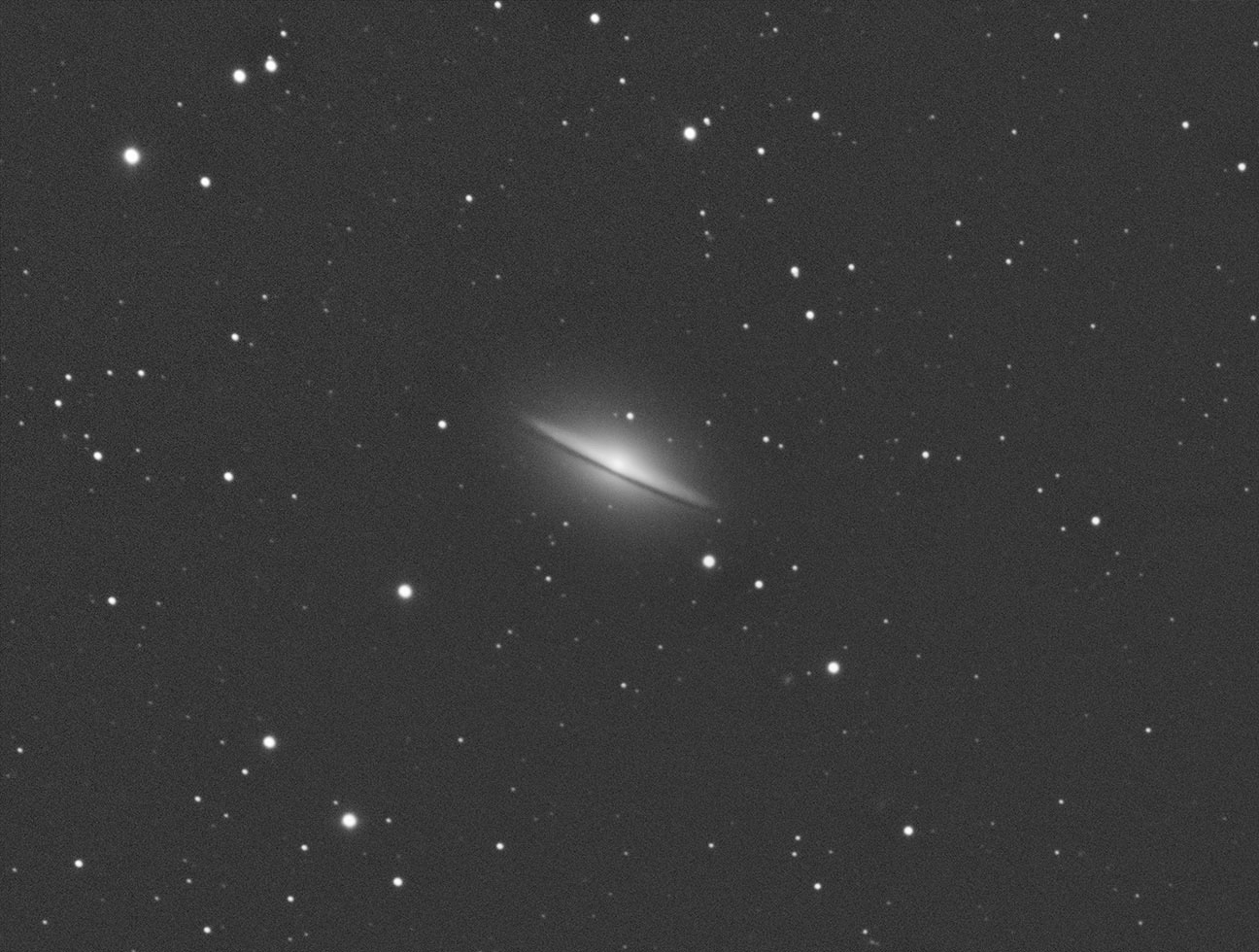
M104 is a large edge on spiral galaxy in southern Virgo.
It never gets very high in the sky from my latitude.
The seeing was only fair this night and I was having guiding difficulties.
This image was taken from Cary, NC using my Celestron Edge HD 800 8" telescope
with a 0.7x telecompressor making the system 1400mm at f/7.
I was using a new (to me) ZWO ASI1600mm-c camera at unity gain.
The scope was guided with an 80mm Brandon refractor and ATIK 16IC.
The mount used was a Losmandy G-11 non-goto.
The image is made from the best 27 of 30 1 minute exposures.
I was afraid using longer exposures due to the light pollution in my neighborhood.
I used MaximDL to capture the image data.
I took 13 darks, 13 flats, and 13 flat-darks for image calibration.
The image data was re-processed using Pixinsight in June 2024.
The image was cropped by approx. 50%.
Click on the image for a larger view in a new window.
Back to the top of the page
Back to Mark's Astrophotography Home
Face on Spiral Galaxy M88 - April 17, 2018
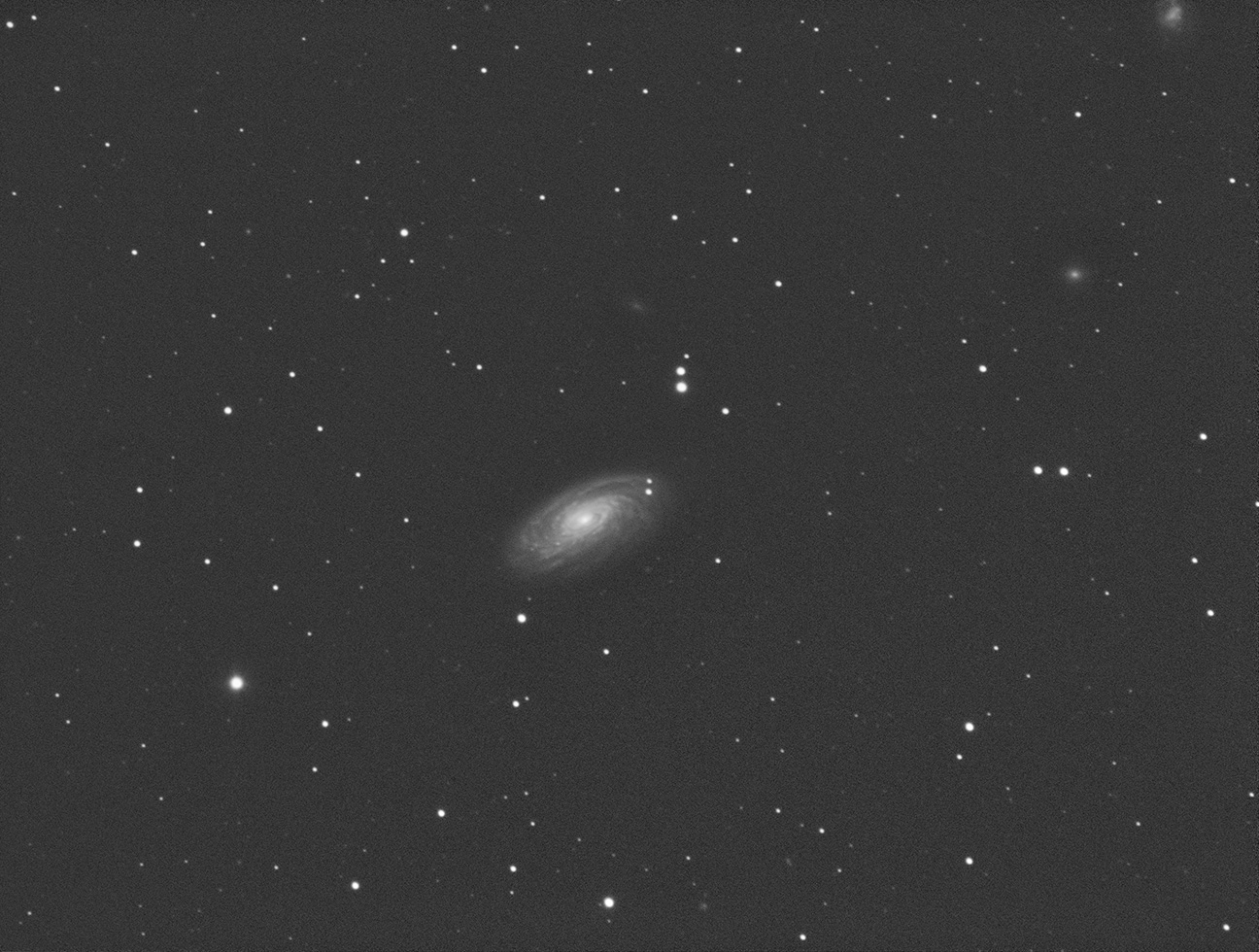
M88 is a pretty face on spiral galaxy in Coma Berenices.
This image was taken from Cary, NC using my Celestron Edge HD 800 8" telescope
with a 0.7x telecompressor making the system 1400mm at f/7.
I was using a new (to me) ZWO ASI1600mm-c camera at unity gain.
This was my first non-test image using this camera.
The scope was guided with an 80mm Brandon refractor and ATIK 16IC.
The mount used was a Losmandy G-11 non-goto.
The image is made from 34 x 1 minute exposures.
Several exposures had to be discarded due to guiding problems.
I used MaximDL to capture the image data.
I took 13 darks, 13 flats, and 13 flat-darks for image calibration.
The image data was processed using PixInsight with a few final tweeks in Photoshop CS.
Click on the image for a larger view in a new window.
Back to the top of the page
Back to Mark's Astrophotography Home
M100, NGC4312, and lots of other galaxies - May 26, 2017
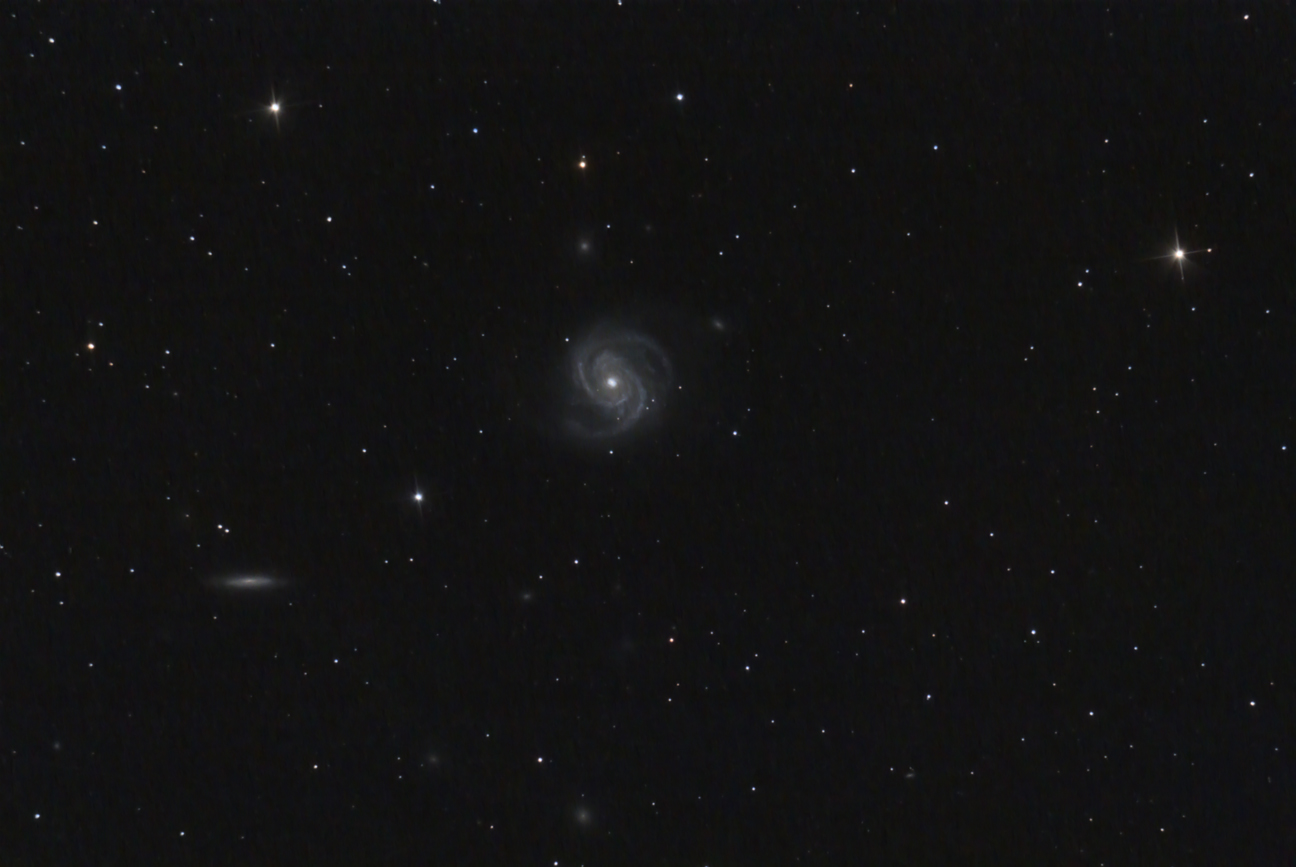
This is the area around spiral galaxy M100 in Virgo. Lots of galaxies are present, the brightest
being edge on spiral NGC4312 to the lower left.
About 10 moderately faint galaxies are in the field of view - the
faintest of which is magnitude 16.2.
North is to the right of the image.
This image slightly cropped is a combination of the best 18 of 25 two and a half minute exposures
taken with my homemade 8" f/6.2 reflector.
The data was acquired at our Bigwoods site on a clear night with temps in the mid to low 60s.
My Losmandy G-11 (non-Gemini) was overtaxed with the weight of this scope but managed to
get some useful images.
I was guiding with my Orion 60mm finder/guider with an attached ATIK 16IC camera.
I was using my Canon Rebel XTi at ISO 1600.
Images were captured with BackyardEOS and reduced and stretched in ImagesPlus.
All other image processing was done with Photoshop CS2.
Click on the image for a larger view in a new window.
Back to Mark's Astrophotography Home
M58, M59, and M60 - May 14, 2017

M58, M59, M60 and lots of other galaxies in Virgo.
Mouse over the image to get an annotated view showing the galaxy designations.
There are 13 brighter galaxies annotated and quite a few much fainter galaxies that are not.
The faintest galaxies are close to 12th magnitude.
This image was taken at Bigwoods on a mostly clear and breezy spring night with temperatures in the upper 60s.
Backyard EOS was used to capture 30 x 1 minute unguided exposures using my mofified Canon XTi at ISO 1600.
I used 11 flats and 13 darks and 13 bias frames.
The images were combined and stretched using ImagesPlus and then taken to Photoshop CS2 for final processing.
I used my Televue Genesis 4" f/5 refractor, an old Canon XTi, and my Losmandy G-11 mount.
Click on the image for a larger view in a new window.
Back to Mark's Astrophotography Home
Spiral Galaxy NGC-4216 - May 11, 2016
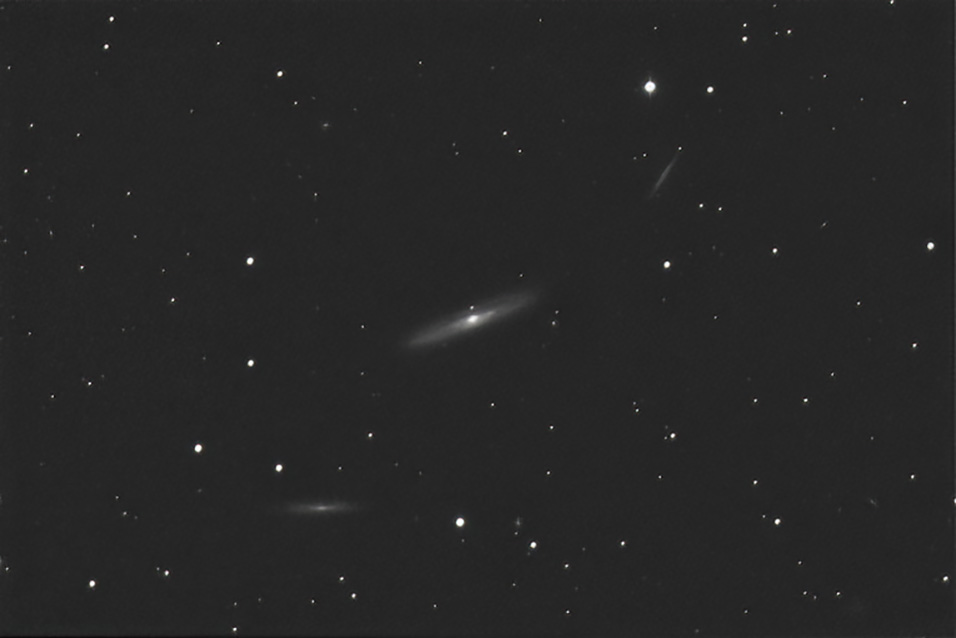
Spiral galaxy NGC-4216 (magnitude 10.9) in Virgo was taken from my light polluted driveway in Cary,
NC on May 11, 2016.
Also seen are edge on spirals NGC-4206 (mag. 12.0) and NGC-4222 (mag. 13.9).
Five or six other small galaxies are also faintly visible.
The photo was taken with my f/5 Genesis refractor and my SBIG ST-402 CCD camera
mounted on my Losmandy G-11.
The photo is luminance only comprising of 20x1 minute exposures.
The data was captured using MaximDL 5.
In March 2020, the original data was reprossed in PixInsight using WBPP.
From PI, the data was taken to Photoshop CC for levels and curves, GradientXterminator, and
Topaz Denoise AI for noise reduction and sharpening.
The image was also enlarged to 125% of the original.
The weather had been cloudy for the dark of the moon period in May,
so in despiration I stepped outside just before bed to check the conditions and I saw stars!
Under less than ideal conditions - moonlight and slightly humid and hazy conditions I set up my scope.
The outside temperature was around 68 degrees F,
so I stayed out for three hours in shorts and a T-shirt just enjoying the night sky.
The data capture started just before midnight and some clouds rolled in at around 12:30
and did not completely go away.
Click on the image to see a larger view in a new window.
Back to Mark's Astrophotography Home
NGC 4725 and NGC 4712 from the suburbs - Mar. 16, 2016
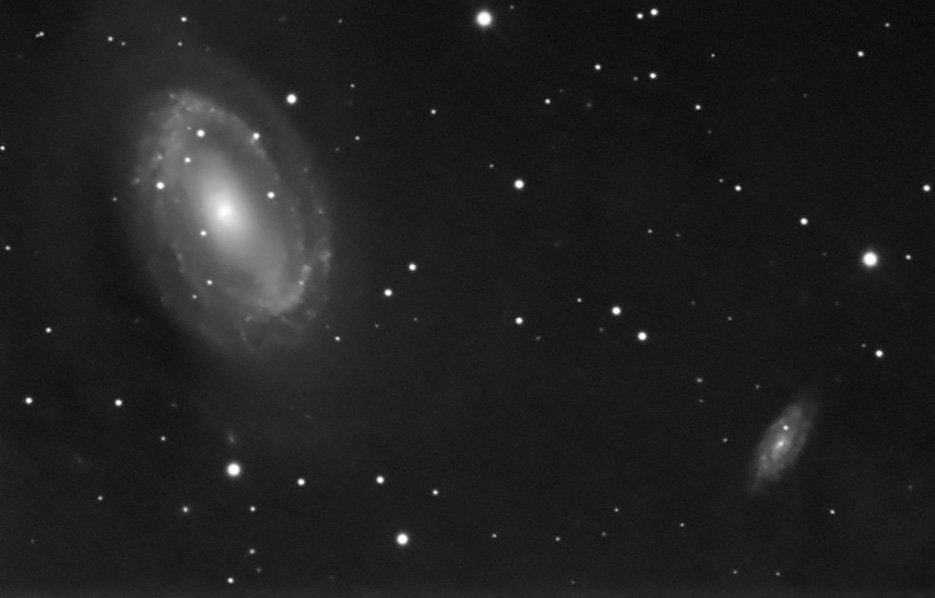
NGC 4725 and NGC 4712 in Coma Berenices captured March 16, 2016.
I wanted to try another deep sky object from the suburbs,
so I arose early and set up my home-built 8" f/6 Newtonian reflector on my Losmandy G-11 mount in the front yard.
I attached my SBIG ST-402 CCD camera and my guide scope combo which is an Orion 60mm finder with an ATIK 16IC.
My neighbors lights were on all night again,
so I had to deal with that direct light coming towards me as well as our new bright LED streetlights.
The skies were clear with low humidity and the temperature was a nice 60 degrees.
Tree pollen was pretty bad.
I combined the best 52 of 53 exposures of 90 seconds in length for a total of 78 minutes exposure time.
PixInsight was used to reprocess this image in April 2024.
In addition to basic processing of the image, I used BlurXTerminator to sharpen the stars and the galaxy
and then NoiseXTerminator to remove noise.
I then cropped out the bad edges and saved the result as a TIFF file.
I took the image into Photoshop CS for a contrast boost, and finally a slight enlargement of the image.
When I originally took my calibration frames,
I found that my flat-fielding box was not working so I had to create flats a couple of days later
after a repair to the light box.
I did use proper darks and bias frames.
Back to the top of the page
Back to Mark's Astrophotography Home
NGC 253 - Dec. 14, 2014

Galaxy NGC-253 in Sculptor taken on Dec. 14, 2014.
It was a cold clear night at Bigwoods with temperatures around 27 degrees F.
These images were captured using the TeleVue Genesis 4" f/5 refractor guided by
a Orion 60mm finder/guider.
16 x 2 minutes sub-exposures were taken with my Canon XTi DSLR.
The data was captured using Backyard EOS then combined and processed with PixInsight in Jan. 2020.
Some touch-ups were done with Photoshop CC.
Click on the image to see a larger version in a new window.
Back to Mark's Astrophotography Home
M33 - The Triangulum Galaxy - Oct. 1, 2013

M33 - The Triangulum Galaxy. This photo was taken at Staunton River Park in Virginia on Oct. 1, 2013. Using the Genesis and the Canon XTi, this was an hour's worth of 3 minute exposures processed in ImagesPlus.
Back to the top of the pageBack to Mark's Astrophotography Home
M84 and M86 area - April 12, 2013
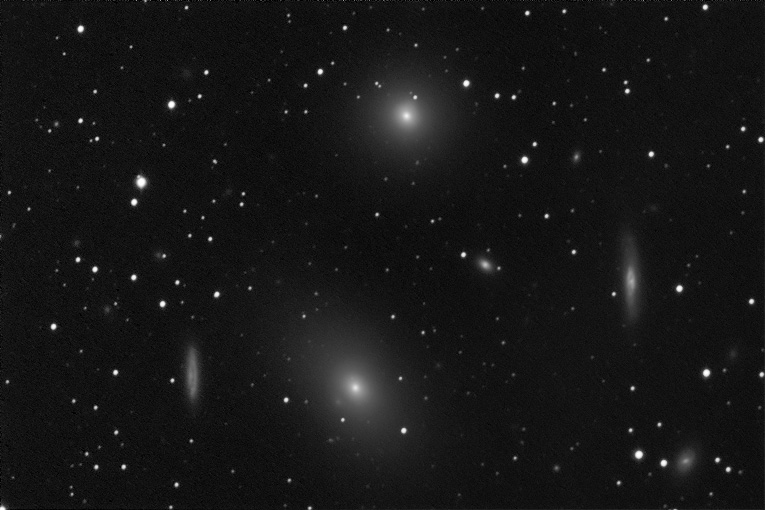
April 12, 2013 at Bigwoods. It is just short of one hour of luminance only exposure using my Televue Genesis 4” refractor and my SBIG ST-402 camera. The shot was guided by a 600mm camera lens attached to my ATIK 16IC camera. North is to the left in this view. M84 is the elliptical galaxy at the top and M86 is the larger elliptical galaxy near the bottom. Also seen are edge on galaxies NGC4402 on the left and NGC4388 on the right. NGC4413 is at the lower right. There are numerous faint galaxies scattered around the photo.
As usual, I had intended to shoot color to go with the luminance but high clouds started rolling into the last couple of frames and I had to stop. The pollen was extremely heavy getting on all my equipment and me. In addition, the seeing was not particularly good.
Back to the top of the pageBack to Mark's Astrophotography Home
NGC 4565 - June 30, 2011
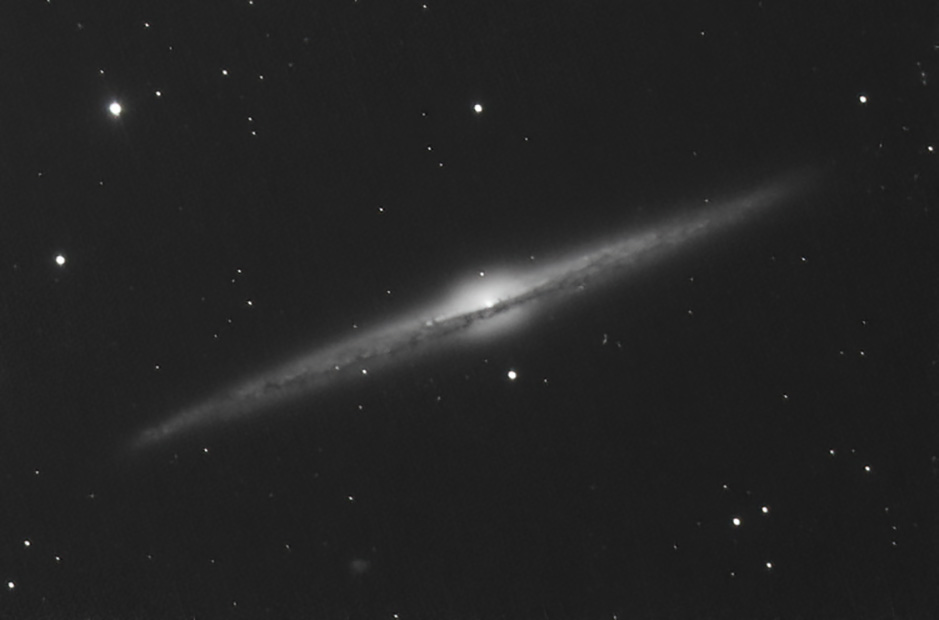
Edge on galaxy NGC 4565 in Coma Berenices taken on Thursday evening June 30, 2011. 31 x 1 min exposures were taken with my homemade 8 inch f/6 Newtonian telescope and my SBIG ST0402me camera on my Losmandy G-11 mount. The image was acquired with Maxim DL. In April 2022, I reprocessed the original data with PixInsight. Finishing touches were done with Photoshop CC and Topaz Denoise AI. The original image was cropped slightly, but then enlarged to 125%. As is usually the case for me, I ran out of time before taking any color data.
Back to the top of the pageBack to Mark's Astrophotography Home
56 year animation of M51 area
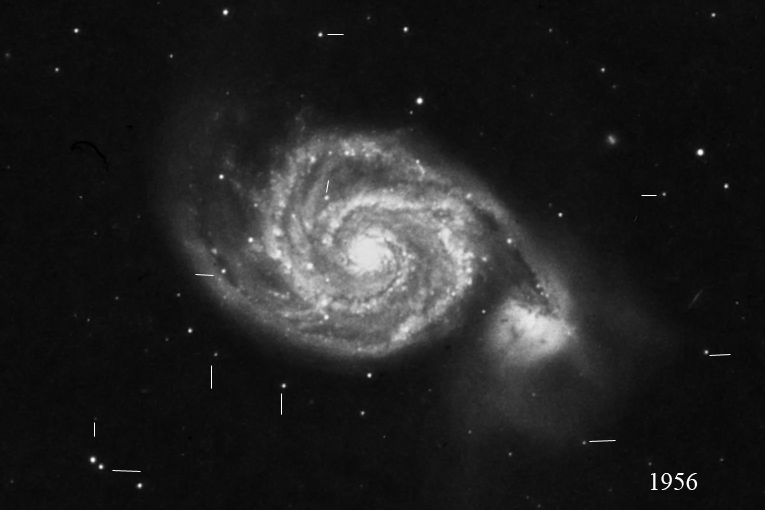
This two frame animation shows the motion of stars in the Milky Way
in the area of M51 the Whirlpool Galaxy over a 54 year period.
I got the idea for this sequence from a similar photo I saw on the Internet recently.
I decided to try one myself using my own photo.
The first image was taken in April, 1956 with the 48" Schmidt telescope on Palomar Mtn.
It is part of the STSci Deep Sky Survey.
I took the second image in July 2010 with my 8" f/6 Newtonian telescope and ST-402 CCD camera.
I manipulated each image by aligning them and then trying to equalize them somewhat.
I put tic marks on most of the brighter stars with the largest proper motion.
It is amazing to me the different directions the stars are moving.
There also seems to be a few variable stars showing different brightness levels.
Back to Mark's Astrophotography Home
M51 - The Whirlpool Galaxy July 3, 2010
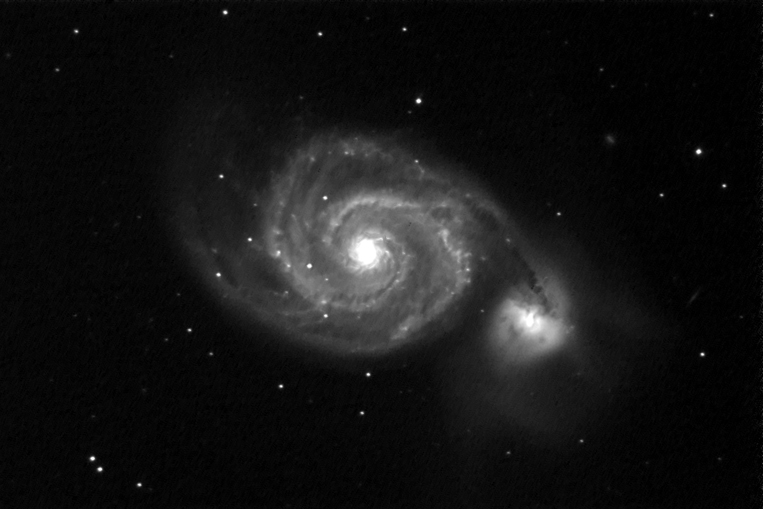
M51 - The Whirpool Galaxy in Canes Venatici on July 3, 2010 at Bigwoods. This is a combination of 26 individual frames some at 2 minutes and some at 1 minute for a total of 39 minutes. DDP was used to bring out the details in the galaxy. I again had tracking problems, so I used Photoshop to bring the stars back into round.
We had beautiful summer weather since a cold front came through and cleared the atmosphere out nicely. Temperatures were in the low to mid 60s. I used my homemade 8 inch f/6 Newtonian and my SBIG ST-402 to create the image. I was guiding piggyback with my ATIK 16IC connected to my 80mm f/6.25 Brandon refractor. I used MaximDL 5 for image acquisition and guiding. The mount used was my 10 year old Losmandy G-11 (non-Gemini). This is the first image through my equipment in quite some time. I have been working out the kinks in the guiding issues I have with my new 8" scope. I still have some work to do!
Back to the top of the pageBack to Mark's Astrophotography Home
M74 - Dec. 25, 2008
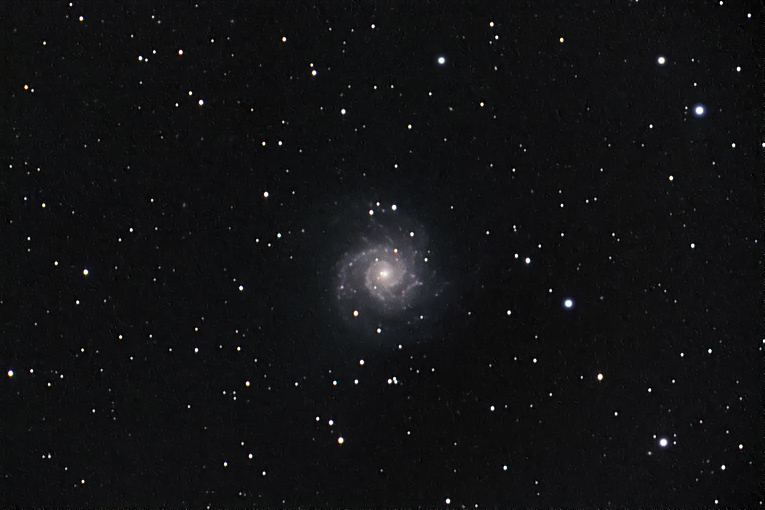
M74 - a spiral galaxy in Pisces. The original data for this image was taken on Dec. 25, 2008 and reprocessed in 2017. The telescope used was the Genesis 4" f/5 on the Losmandy G-11 mount. The LRGB composit was made from 30 minutes of luminance binned 1x1, red and green at 5x3 minutes each binned 2x2, and blue 6x3 minutes binned 2x2. Data was captured, reduced, and combined with MaximDL 5, then finished up in ImagesPlus and Photoshop CS2.
Back to the top of the pageBack to Mark's Astrophotography Home
NGC 2903 - April 8, 2007
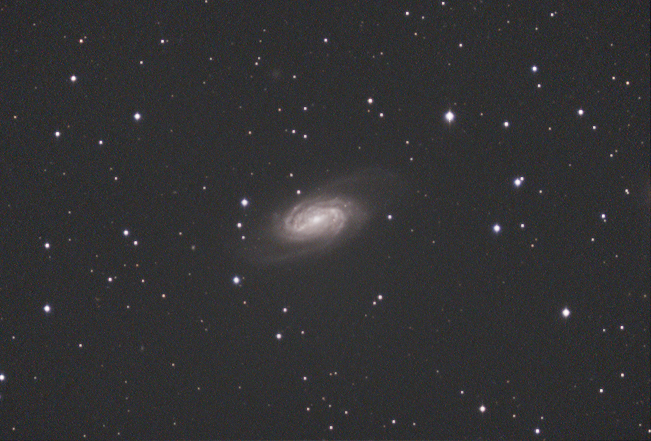
NGC-2903 April 8, 2007 - This is a nice little barred spiral galaxy in Leo that Bill Webster showed me a couple of years ago. This LRGB image was made up of 21 minutes of luminance, 15 minutes each of red and green, and 18 minutes of blue for a total of 69 minutes of exposure time. Above the spiral galaxy there is a small galaxy UGC-5086 at magnitude 16. Although we had had some nice spring weather a few days before, it seemed like winter again with temperatures in the lower 30s. The skies were clear. I was using the 4 inch Genesis and the ST-402ME to image and the Stellarvue 80mm and ST-4 to guide. This old data was reprocessed in PixInsight and Photoshop CC in Aug. 2020 and presented here.
Back to the top of the pageBack to Mark's Astrophotography Home